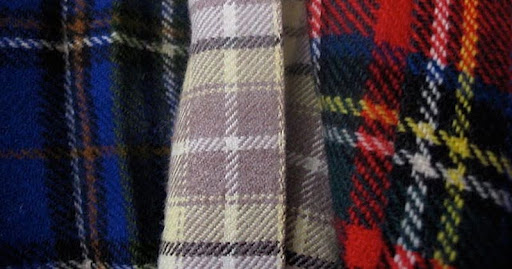What Is Scottish Tartan & How to Find Your Own
Scottish tartan, an emblem of Scottish heritage, is recognized worldwide for its distinctive patterns of crisscrossed horizontal and vertical bands in multiple colors. Originating from the traditional dress of the Highland clans of Scotland, tartan has transcended its regional roots to become a global symbol of identity and belonging. In this comprehensive article, we will explore what Scottish tartan is, delve into the meanings behind different tartans, address who can wear tartan, and guide you on how to find or create your own tartan.
What Is a Tartan?
A tartan is a patterned cloth consisting of crisscrossed horizontal and vertical bands in multiple colors. Traditionally made of wool, these patterns are known for their interlocking stripes of different colors and widths. The design is unique in that it appears the same on the front and back of the cloth, achieved by weaving threads of various colors in a specific sequence both in the warp and weft. Tartans were originally associated with Scottish regions and later came to be identified with Scottish clans, families, and institutions. Each tartan pattern, or set, is a visual representation of a clan’s heritage and history, often designed with colors symbolizing significant elements of the clan’s regional and familial stories.
The Cultural Impact of Tartan
Beyond personal connections, tartan has a significant cultural impact. It is often seen in celebrations and ceremonies worldwide, symbolizing not just Scottish pride but also the universal themes of kinship and belonging. Tartan Day, for example, is celebrated in various countries on April 6th each year, commemorating the historical and cultural links between Scotland and those of Scottish heritage living abroad. Additionally, tartan has made its way into modern fashion and pop culture, further solidifying its status as an icon of design. From runway fashion shows to popular television series, tartan continues to be a chosen fabric to convey stories of heritage, identity, and resistance.
Do Tartans Have Different Meanings?
Indeed, each tartan pattern holds a specific meaning, conveying stories and symbolism through its colors and sequences. Historically, the colors used in tartans could be derived from local dyes, which would be made from plants, berries, and trees available in the area, thus linking a clan’s tartan to their geographical surroundings.
For example, the color green often represents the lush landscapes of Scotland, blue can signify lakes and rivers, while red might denote the bloodline of the clan or historical battles. Beyond the colors, the specific arrangements and widths of the bands can also signify factors such as allegiance to a larger clan, marital links, or political alliances.
Can I Wear a Tartan If I’m Not Scottish?
Tartan is not exclusive to those of Scottish descent. While tartans are often seen as a representation of lineage and are worn with pride by clan members during Scottish ceremonies and gatherings, they have grown to become a universal symbol of Scottish heritage and are worn worldwide. Tartans today are embraced by many as a fashion statement and a way to honor Scottish culture, regardless of the wearer’s heritage. It’s also common to see tartans used by various institutions, corporations, and regions, further broadening their appeal beyond individual lineage. For instance, several American states have official tartans registered to represent their connections with the Scottish heritage of many of their citizens.
How to Get Your Own Tartan
Finding a tartan connected to your surname or heritage can be a meaningful way to embrace and celebrate your family history. The first step in discovering your own tartan is to research whether your surname is associated with a Scottish clan. Several online registries and databases can help identify if a tartan is linked to your family name. These resources often provide the history and images of the tartan, along with information about the clan. If your surname does not have an associated clan or tartan, regional tartans may offer an alternative. Many Scottish regions have their own tartans, representing the geographical area rather than a specific family.
Can I Create My Own Tartan?
If you do not have a personal connection to a pre-existing tartan or simply wish to create a unique pattern that represents your own story or organization, designing a custom tartan is a feasible option. This process involves selecting colors that are significant to you or your group and deciding on a specific pattern that reflects your identity. Creating a tartan involves adhering to traditional weaving techniques, which means the pattern must be capable of being mirrored or reversed on both the horizontal and vertical axes. Various companies and tartan designers specialize in custom tartans and can assist with the design and registration process. Custom tartans can also be officially registered with The Scottish Register of Tartans, an official database that records and preserves details of all known Scottish tartans. Registration ensures that your unique tartan is recognized and recorded in Scottish history.
Discover Authentic Tartans at Scottish Kilt
Explore the rich tradition of Scottish tartans with Scottish Kilt, your premier destination for authentic tartan apparel and accessories. Whether you’re connecting with your heritage, seeking a regional tartan, or designing a unique custom pattern, Scottish Kilt offers high-quality, traditional and modern tartan designs. Their bespoke service helps you create and register your own tartan, ensuring it becomes a recognized part of Scottish history. From kilts to scarves and ties, each product combines craftsmanship with contemporary style, perfect for formal events, Scottish ceremonies, or daily wear. Choose Scottish Kilt to express your Scottish pride elegantly and authentically. Visit Scottish Kilt today to start your journey into the world of tartans.
Conclusion
Scottish tartan remains a vibrant and compelling element of Scotland’s cultural export and heritage. Whether you are exploring your direct lineage to a Scottish clan, connecting with a region of Scotland, or creating a completely new tartan that tells your personal or organizational story, the world of tartans offers a rich tapestry of opportunities for expression and connection. In wearing or creating a tartan, individuals carry forward the threads of history into the fabric of contemporary life, ensuring that this beautiful tradition continues to be cherished and evolved for generations to come.







